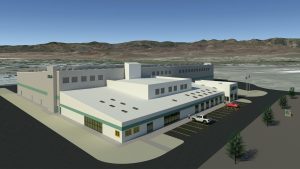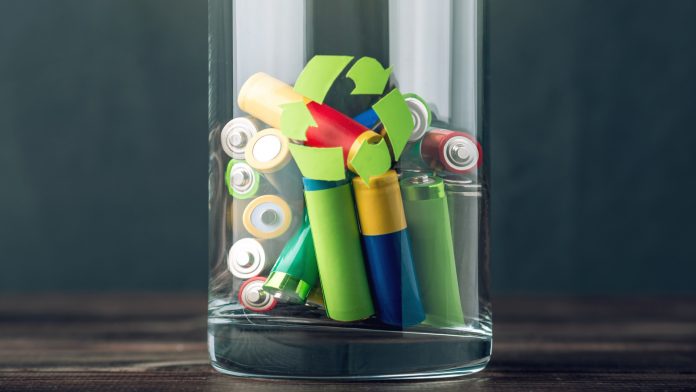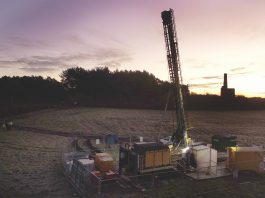American Battery Technology Company’s Chief Technology Officer, Ryan Melsert, discusses the company’s battery recycling process and green energy verticals.
The lithium-ion battery industry is experiencing a period of extreme growth with a more than 20-fold increase in annual production projected over the next 10 years (~150 GWhr in 2018 versus more than 3,000 GWhr in 2028). This dramatic growth in the manufacturing of batteries is creating an insatiable appetite for the raw metals and refined feedstocks that feed these Gigafactories.

According to American Battery Technology Company’s (ABTC) Chief Technology Officer, Ryan Melsert, formerly the R&D Manager for Battery Materials Processing at Tesla, while new mining and refining facilities are coming online throughout the world to attempt to meet this growing demand, secondary materials harvested through recycling processes will play a transformational role in the new energy revolution.
So when Melsert met ABTC CEO Doug Cole, a clean energy collaboration was born. The two were introduced by a member of ABTC’s team who first met Melsert at a battery metals industry conference. In the ensuing months, follow-up discussions included solidifying ABTC’s goals for increasing domestic production of critical materials, as well as Melsert’s plans to implement a proprietary, first-of-its-kind, lithium-ion battery recycling process in a fully integrated facility. Cole and Melsert quickly realised that their goals were strategically aligned, and they agreed to join forces.
The new team at ABTC developed a novel lithium-ion battery recycling process that takes in feedstock from end-of-life batteries from electric vehicles, consumer electronics and tools, and energy storage projects, as well as scrap and waste materials from the battery manufacturing process.
Formerly a lithium exploration company with land assets in Nevada, ABTC has grown into a clean technology platform that creates a circular economy for battery metals and sets a new standard as a champion for the ethical and environmentally sustainable sourcing of critical materials. ABTC has three main business units:
- The recycling of lithium-ion batteries to recover and reuse battery metals;
- The extraction of battery metals from primary resources; and
- The exploration and stewardship of new mineral resources globally.
Identifying the Problem with the lithium-ion battery industry
Melsert and members of the ABTC technical team previously evaluated some of the largest manufacturers of lithium-ion batteries in the world, tasked with identifying and vetting both the manufacturing processes and the battery recyclers who processed defective and end-of-life batteries that were being collected. It was this investigation that allowed Melsert and his colleagues to identify significant shortcomings in the nascent lithium-ion battery recycling field.
“The current landscape for the recycling of lithium-ion battery materials consists of a series of disjointed facilities that attempt to process this feedstock in a manner similar to that of conventional waste metals,” stated Melsert. “This process generally consists of a facility for bulk electrical discharging of the packs, modules, and cells and followed by manual disassembly of the packs and modules into cells and support material. A second facility roasts or shreds the individual cells and then extracts metal concentrates through either smelting or leaching and hydrometallurgy trains.”
According to Melsert, these extracted metals are often sent to a third facility for additional purification and conversion into battery grade feedstocks. This disjointed operation incurs high logistics and transportation costs, long residence times of up to eight weeks, high chemical reagent costs, and low recovery of economic value, as generally only nickel, cobalt, and copper are recovered, while the aluminium, manganese, and lithium are landfilled, and an overall low economic return.
Although there is increasing interest in new projects, the current lithium-ion battery recycling industry lacks maturity and is fraught with inefficiencies. As a result, the industry has not been able to offer attractive economic returns and, as a result, it has been reported that globally less than 5% of all lithium-ion battery materials are currently recycled. The potential value that can be extracted from these end-of-life batteries is a staggering $500m per year in 2018, rising to over $5bn per year by 2028.
The ABTC lithium-ion battery solution
To address this burgeoning need and untapped economic opportunity, ABTC has assembled a technical team that includes industry leaders in the ground-up design, construction, and operation of one of the largest lithium-ion battery factories in the world, and who have first-hand knowledge of the opportunities that exist for the recovery and reuse of these high value materials. Through a methodical process informed by the reverse manufacturing, or ‘de-manufacturing of batteries’, Melsert and his team have developed a proprietary recycling train designed to economically recycle end-of-life battery packs and material waste from every step of the manufacturing process as well.
Instead of attempting to fit the feedstocks into existing recycling processes, the ABTC first-of-kind processing train was created from a first principles design specifically for these battery materials and for the production of battery grade feedstocks.
With these guiding principles and a fundamental understanding of the chemical processing and physics of manufacturing battery cells and packs, ABTC validated a system that is self-contained in a single facility and is able to feed up to fully charged, complete battery modules without manual disassembly. The process exhibits extremely low chemical reagent costs through innovative regeneration techniques, recovers all metallic element species (including aluminium, manganese, and lithium), and achieves extremely attractive economic profitability.
The ABTC recycling process consists of two primary loops. The first is a mechanical processing loop, which takes in non-electrically discharged batteries as assembled modules, cells, and battery materials. It uses automated machinery to disassemble and separate these feedstocks into their individual components.
These separated components include material from the module (aluminium, iron/steel, and plastics), casing material from the cells (aluminium/iron/steel), substrate foils from the electrodes (aluminium and copper), dielectric separators, a liquid product consisting of liquid electrolyte and dissolved solids, and a solid pressed cake of powders known conventionally as black mass.
The aluminium, copper, and iron/steel products are sold to the commodity scrap markets. The liquid stream is processed and recycled by an inline water treatment system. The treated water is then recycled through this process and is cleaner at the end of the treatment train than it was entering the ABTC facility from the original municipal water source.
The black mass is then fed through ABTC’s chemical processing loop. As the black mass goes through acid dissolution, impurity removal, and selective extraction processes, the ABTC recycling train generates four additional products: battery grade powders of nickel sulphate, cobalt sulphate, manganese sulphate, and lithium hydroxide.
The remaining brine consists primarily of counter-ions from the acid and base reagents used during the dissolution and extraction processes. Through a proprietary and highly energy efficient regeneration process, these counter-ions are regenerated back into new acid and base feedstocks to be reused in a closed loop fashion.
While these two loops are designed to operate in a complementary synergy with each other, they are also able to operate independently.
The implementation of this system in this manner allows for substantially lower capital costs up front for only constructing the first primary loop. It also allows for resources to be focused on the commissioning and optimisation of the mechanical operations before adding in the complexities of the second loop. Together, this reduces the financial risks associated with building ABTC’s pilot facility, which is anticipated to go online in late 2021.
Additionally, this approach allows ABTC to plan for future commercial facilities, which are each slated to handle in excess of 100,000 MT/year. ABTC is currently evaluating several locations in the US and abroad that can be optimised for quick scaling and ease of logistics.
The ABTC recycling solution creates circularity in the value chain by taking in battery materials – both at the end-of-life in pack form and also during the manufacturing process in the forms of waste and defects – that are recycled back into battery-grade metals. These waste products include: powders of active materials, pressed sludges of active materials extracted from wastewater treatment systems, full active material slurries, coated and uncoated electrodes, wound and stacked electrode unit cells, unsealed cells, defect sealed cells, and modules under all states of assembly.
The ABTC recycling process is able to extract and purify elemental products into battery grade materials. The ABTC technical team has deep experience establishing the qualification and quality control standards that define how battery grade feedstocks are validated by one of the largest battery manufacturers in the world. Designing a system from the ground up to ensure that these feedstocks will meet battery grade standards will enable these extracted metallic products to be returned to the battery supply chain in a closed-loop circular fashion.
Creating a sustainable future
ABTC’s platform centres around the goal of delivering clean, safe, and secure energy through innovative and sustainable processes. Each piece of ABTC’s closed-loop recycling process – from energy and water use to eliminating air emissions – helps the company meet its environmental and social objectives to increase production of battery metals in ways that address climate change and contribute to local economies. ABTC is paving the way to produce high purity materials that fuel the global transition to renewable energy. The no-waste and environmentally sustainable processes outlined above, combined with the fact that the pilot plant will be powered through renewable energy to reduce emissions, enable ABTC to positively impact multiple battery metal supply streams and improve the country’s progress towards a greener future.
ABTC is one of the few companies developing a circular economy for battery recycling and that will enable the company to play a transformational role in localising the supply chain to reduce geopolitical, environmental, and labour risks. This transition will necessitate a significant shift for the United States and will require political will and strategic public/private collaborations to incentivise high-volume recycling of lithium-ion batteries and streamline the complex network of policies that govern transport and storage of battery feedstock.
The United States today is woefully dependent on foreign sources for the critical materials, including battery metals like lithium, cobalt, and nickel, that are essential for a battery-powered future. For example, lithium demand is projected to explode over the coming years. Yet, approximately 87% of all lithium today is sourced from three countries (Australia, Chile, and China)1 and experts predict a shortfall of up to 250 kilotons annually by 2030.2
Such dependence jeopardises America’s energy security and economic future. Foreign sources often rely on business practices that ignore environmental sustainability, labour protections, or anti-corruption standards. Moreover, as countries implement increasingly protectionist policies, these critical materials could be withheld by foreign suppliers, exposing our nation’s economy and energy security to unnecessary risk. As we witnessed throughout the COVID-19 pandemic, when certain countries locked down, supply chains were interrupted temporarily, with greater emphasis on serving national needs rather than international customers.
The Biden Administration acknowledged these supply chain risks in a recent Executive Order on domestic supply chains, which is designed to evaluate and mitigate the inherent geopolitical, economic, and environmental risks of continuing our foreign dependence. The US Critical Minerals Institute (CMI), an energy innovation hub of the US Department of Energy (DoE), focuses on the research, development, and commercialisation of new technologies to enable and scale the domestic manufacturing of critical minerals within the US to address these national security and environmental impact challenges. This institute is comprised of many of the premier researchers and corporations within the critical materials industry, and ABTC is humbled that in early 2021 ABTC CTO, Ryan Melsert, was appointed to the technical advisory board of the CMI to help guide its direction and technology roadmap.
America’s energy security demands that the country move quickly to secure and advance its abundant domestic sources of critical materials. The two greatest sources of lithium in the US come from the deposits within the ground, and also the increasing number of lithium-ion batteries that have reached the end of their operating lives from cars, phones, and other personal electronics. While end of life EV batteries will scale over time, cell phones, computers, and power tools comprise a large portion of the potential feedstock and these items are ready to be recycled now instead of being thrown into landfills, where their potential value will remain untapped.
ABTC is an active policy proponent of the notion that access to critical materials is a problem best solved by strategic partnerships that marry the economic efficiency and flexibility of the private sector with the national security mission of public sector policy making. By establishing such partnerships, government agencies can strengthen domestic supply chains by promoting investment in technologies that unlock domestic sources of critical materials and removing barriers that prevent this new infrastructure from growing and scaling.
The United States Department of Energy’s recent investment in US-based companies that are producing critical minerals illustrates a useful model for such partnerships. ABTC was selected by the DoE’s Advanced Manufacturing Office with a $4.5m dollar grant to advance its insert ‘internally developed first-of-kind process for the extraction and manufacturing of battery grade lithium hydroxide from Nevada-based claystone sedimentary resources.
ABTC’s grant partners are DuPont Water Solutions and American Lithium, whose Tonopah, Nevada TLC Project covers 6,000 contiguous acres and represents one of the largest lithium resources in North America where ABTC’s extraction methods can be proven in the field and at a large scale. With the support of this grant, scientists from all three companies and the DOE will work together to extract lithium from unique claystone deposits in a fast, economical, and environmentally sustainable way. Their success promises to transform the domestic US availability of lithium to fuel American energy needs while furthering America’s clean energy, circular economy, and importance in the global supply chain.
The recent U.S. Executive Order on America’s Supply Chains encourages greater government collaboration with companies like ABTC, DuPont Water Solutions, and American Lithium to address vulnerabilities in the supply chain, which will also lead to significant growth of new green jobs around the country. ABTC has committed to creating at least 50 new jobs within local communities in Nevada in the next two years as a result of its lithium ion battery recycling pilot plant and DoE grant investment, a number that could grow by several hundred within five years. American Lithium will see similar numbers from the outset of the initial joint project.

The Executive Order on America’s Supply Chains follows a complementary Critical Minerals Executive Order released in 2018, and together the Executive Orders are an important, bipartisan step toward securing America’s supply chains. But much more work is needed; from new procurement policies that support domestic suppliers of critical materials, the establishment of a strategic reserve of such metals to avoid supply chain disruptions, and greater incentives for recycling and domestic extraction, to updating the regulatory environment to recognise the tremendous innovations that have taken place in safety, transport, recycling, and other extraction and production practices. The resulting non-partisan, co-ordinated effort will strengthen the US domestic supply chain, accelerating toward a ‘battery-powered’ economy and enhance US and global economic security.
References
- International Energy Agency (2020), Clean energy progress after the Covid-19 crisis will need reliable supplies of critical minerals, IEA, Paris www.iea.org/articles/clean-energy-progress-after-the-covid-19-crisis-will-need-reliable-supplies-of-critical-minerals
- Greim, P., Solomon, A.A. & Breyer, C. ‘Assessment of lithium criticality in the global energy transition and addressing policy gaps in transportation’. Nat Commun 11, 4570 (2020). ttps://doi.org/10.1038/s41467-020-18402-y
Please note, this article will also appear in the sixth edition of our quarterly publication.









